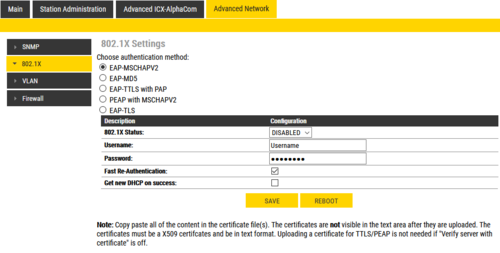IEEE 802.1X
From Zenitel Wiki
IEEE 802.1X is an IEEE Standard for port-based Network Access Control (PNAC). By "port" we mean a single point of attachment to the LAN infrastructure. It provides an authentication mechanism to devices wishing to attach to a LAN, either establishing a point-to-point connection or preventing it if authentication fails.
Contents
User interface
The 802.1X configuration is done from the IP-station web interface at Advanced Network > 802.1X.
Choose authentication method. The different authentication methods are:
- MSCHAPV2
- MD5
- TTLS with PAP
- PEAP with MSCHAPV2
- TLS
MSCHAPV2 and MD5 encrypts the password.
TTLS with PAP and PEAP with MSCHAPV2 encrypts both username and password.
Depending on the authentication method there are a few parameters to configure.
- 802.1X status: Enable or disable 802.1X
- Username: The username used to identify a station.
- Password: The password associated with the username.
- Fake username ["TTLS with PEAP" and "PEAP with MSCHAPV2" only]: The fake username sent outside of encrypted tunnel with TTLS with PAP and PEAP with MSCHAPV2. The user name is encrypted.
- Verify server with certificate [TTLS with PEAP, PEAP with MSCHAPV2 and TLS only]: Specifies that the client verifies that server certificates presented to the client have the correct signatures, have not expired, and were issued by a trusted root certification authority (CA). It's enabled by default.
- Fast Re-Authentication: EAP peer and an EAP server authenticate each other through a third party known as the EAP authenticator. When a peer moves from one authenticator to another, it is desirable to avoid a full EAP authentication to support fast handovers.
- Get new DHCP on success: If 802.1X authentication is successful, station will restart it's DHCP client.
- Insert CA Certificate [TTLS with PEAP, PEAP with MSCHAPV2 and TLS only]: Upload certificate (public key) used by authentication server. This is not required if "Verify server with certificate" option is disabled.
- Insert User Public Certificate [TLS only]: Upload certificate (public key) used by authentication client (user).
- Insert User Private Key [TLS only]: Upload the private key which is paired with user public certificate.
- Click Save to save the current settings
- Click Reboot. The new 802.1X settings will only come into effect after a reboot.
802.1X and software upgrade
INCA stations and Turbine
Software upgrade is not possible when a station is using 802.1X authentication.
In order to upgrade the station, one must either:
- Remove security on the switchport, upgrade and set security back on the switchport.
- Connect the station to a non-802.1X port and do a manual upgrade.
Note that in the Turbine stations the 802.1x certificate does not survive a software upgrade. The certificate must be uploaded to the station again after a software upgrade.
The reason that the station cannot be upgraded is that during the upgrade of the IP-station, 802.1X will not be running. Thus if 802.1X reauthentication is enabled and is performed during upgrade, the IP-station will lose contact with the tftp server (dependent on the configuration when 802.1X authentication fails). If the IP-station loses contact with the tftp server, it will not be upgraded. The same is also valid when upgrading via VS-IMT.
Software requirement
802.1X is supported:
- In INCA stations as from firmware 1.09.3.0.
- In Turbine stations in all firmware versions.
- In Pulse mode as from firmware 4.7 (Turbine) and 2.7 (INCA). (Previously supported only in SIP and AlphaCom mode).
- In ICX-AlphaCom, as from software version 1.1.3.0


